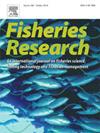Recruitment, growth, and exploitation as determinants of brook trout size structure in natural lakes
IF 2.3
2区 农林科学
Q2 FISHERIES
引用次数: 0
Abstract
Recreational fisheries are globally significant both culturally and economically, yet unmanaged harvest can erode population structure and sustainability. This study evaluates the long-term effectiveness of a trait-informed harvest regulation combining reduced daily bag limits with weight-based harvest caps on brook trout (Salvelinus fontinalis) populations in eight unstocked, oligotrophic lakes in Newfoundland, Canada. Over 15 years (1994–2008), standardized index netting and winter creel surveys were used to assess changes in fish size structure and angler behaviour. Mixed-effects models revealed significant increases in maximum length (Lmax), mean length at capture (Lc), and proportional size distribution (PSD) following regulation implementation, with no significant changes in catch rate, effort, or release rate. We applied a variance partitioning framework to identify mechanisms driving PSD improvements, attributing 31 % of PSD variation to growth, 18 % to recruitment, and 7 % to exploitation. These findings demonstrate that biologically grounded regulations can enhance fishery quality while maintaining angler engagement. The study offers one of the first empirical demonstrations of PSD driver partitioning in a wild brook trout fishery. It provides evidence to support adaptive, trait-informed management in recreational salmonid systems.
天然湖泊中鳟鱼大小结构的决定因素:招募、生长和开发
休闲渔业在文化和经济上都具有全球意义,但未经管理的捕捞会破坏人口结构和可持续性。本研究评估了在加拿大纽芬兰的8个无放养的贫营养湖泊中,结合减少每日袋限和基于体重的鳟鱼(Salvelinus fontinalis)种群的收获规定的长期有效性。在过去的15年里(1994-2008),标准化指数网和冬季鱼网调查被用来评估鱼的大小结构和垂钓者行为的变化。混合效应模型显示,在法规实施后,最大长度(Lmax)、平均捕获长度(Lc)和比例大小分布(PSD)显著增加,而捕获率、努力量或释放率没有显著变化。我们应用方差划分框架来确定驱动PSD改进的机制,将31% %的PSD变化归因于增长,18% %归因于招聘,7% %归因于开发。这些发现表明,基于生物学的法规可以提高渔业质量,同时保持垂钓者的参与度。该研究提供了野生溪鳟渔业中PSD驱动分区的第一个实证证明之一。它为娱乐性鲑鱼系统的适应性、特征信息管理提供了证据。
本文章由计算机程序翻译,如有差异,请以英文原文为准。
求助全文
约1分钟内获得全文
求助全文
来源期刊

Fisheries Research
农林科学-渔业
CiteScore
4.50
自引率
16.70%
发文量
294
审稿时长
15 weeks
期刊介绍:
This journal provides an international forum for the publication of papers in the areas of fisheries science, fishing technology, fisheries management and relevant socio-economics. The scope covers fisheries in salt, brackish and freshwater systems, and all aspects of associated ecology, environmental aspects of fisheries, and economics. Both theoretical and practical papers are acceptable, including laboratory and field experimental studies relevant to fisheries. Papers on the conservation of exploitable living resources are welcome. Review and Viewpoint articles are also published. As the specified areas inevitably impinge on and interrelate with each other, the approach of the journal is multidisciplinary, and authors are encouraged to emphasise the relevance of their own work to that of other disciplines. The journal is intended for fisheries scientists, biological oceanographers, gear technologists, economists, managers, administrators, policy makers and legislators.
 求助内容:
求助内容: 应助结果提醒方式:
应助结果提醒方式:


